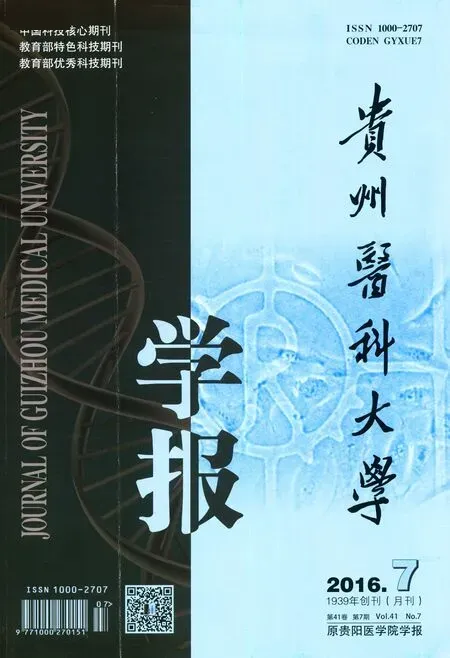哮喘患者CD4+CD25+调节性T细胞比例与炎症因子的相关性*
高 炜
(北京市仁和医院, 北京 102600)
哮喘患者CD4+CD25+调节性T细胞比例与炎症因子的相关性*
高炜
(北京市仁和医院, 北京102600)
[摘要]目的: 探讨哮喘患者外周血CD4+CD25+调节性T细胞比例与血清中炎症因子的相关性。方法: 110例哮喘患者均分为哮喘急性发作组和哮喘缓解组, 55例健康体检者作为对照组;用流式细胞仪测定哮喘患者外周血中CD4+CD25+调节性T细胞的比例,酶联免疫法(ELISA)检测被检者血清中白细胞介素18(IL-18)、IL-4及转化生长因子β(TGF-β)含量;用Spearman统计方法分析哮喘患者外周血中CD4+CD25+调节性T细胞的比例与血清中IL-18、IL-4和TGF-β含量的相关性。结果: 与对照组比较,哮喘缓解组、哮喘急性发作组患者全血细胞中CD4+CD25+ T细胞比例降低,血清中IL-18、IL-4及TGF-β含量升高(P<0.05);与哮喘缓解组比较,哮喘急性发作组外周血中CD4+CD25+ T细胞的比例降低而血清中IL-18、IL-4及TGF-β含量升高(P<0.05);Spearman相关分析结果显示,哮喘患者外周血CD4+CD25+ T细胞比例均与血清IL-18、IL-4和TGF-β含量呈显著负相关关系(r=-0.712、-0.629、-0.593,P=0.006、0.008、0.005)。结论: 外周血CD4+CD25+ T细胞的比例与哮喘的发生和发展密切相关,其机制可能与IL-18、IL-4和TGF-β升高有关。
[关键词]哮喘; 白细胞介素类; 转化生长因子β; CD4+CD25+调节性T细胞; 因素分析,统计学
哮喘是一种与气道高反应性密切相关的慢性炎症疾病,调节性T细胞(regulatory T cells)分化异常与哮喘的发病机制中的炎症细胞及炎症介质有关[1]。尤其是CD4+CD25+T细胞以其独特的作用方式和功能特征,在支气管哮喘的发生发展中发挥着重要作用[2-4]。本研究通过检测不同哮喘患者外周血CD4+CD25+T细胞的变化及其与炎症因子水平的关系,探讨CD4+CD25+T细胞在哮喘中的作用机制及其与炎症反应的相关性。
1资料与方法
1.1一般资料
110例哮喘患者分为哮喘急性发作组和哮喘缓解组,每组55例。所有患者均符合中华医学会呼吸病学分会制定的支气管哮喘防治指南对哮喘的诊断标准及分级标准[5],近1月内未使用过其它哮喘治疗类的药物。排除合并心脑血管疾病、慢性支气管炎、支气管扩张、肺结核等其他肺部疾病的患者,排除近1月内有呼吸道感染者,或近期口服或吸入糖皮质激素的患者。哮喘急性发作组男31例,女24例,年龄41~72岁,平均(53.2±8.3)岁;哮喘缓解组男34例,女21例,年龄39~76岁,平均(51.9±6.8)岁。本研究得到医院伦理委员会的批准,全部受试者均知情同意。另选取同期门诊健康体检者55例作为对照组,男34例,女21例,年龄39~76岁,平均(51.9±6.8)岁。对照组均无各器官系统急慢性疾病及过敏性疾病史。
1.2方法
全部受检者均于清晨采集空腹静脉血 5 mL,其中2.5 mL 3 000 r/min离心3 min分离血清,置于-20 ℃保存,用于检测白细胞介素18(IL-18)、IL-4及转化生长因子-β(transforming growth factor-β,TGF-β)含量,采用酶联免疫法(ELISA)检测,试剂盒购自Biosource 公司;另2.5 mL血液抗凝后,采用流式细胞仪(Beckman-CoulterXL100)测定CD4+CD25+T细胞数,计算外周血中CD4+CD25+T细胞比例。
1.3统计学方法

2结果
2.1CD4+CD25+调节性T细胞比例
与对照组比较,哮喘急性发作组、哮喘缓解组患者外周血中CD4+CD25+T细胞比例降低,哮喘急性发作组最低,差异有统计学意义(P<0.05)。见表1。

表1 3组受检者外周血中CD4+CD25+调节性T细胞比例
(1)与对照组比较,P<0.05;(2)与哮喘缓解组比较,P<0.05
2.2IL-18、IL-4及TGF-β含量
哮喘急性发作组和哮喘缓解组血清中IL-18、IL-4及TGF-β含量高于对照组,差异有统计学意义(P<0.05);哮喘急性发作组的IL-18、IL-4和TGF-β含量高于哮喘缓解组,差异有统计学意义(P<0.05)。见表2。
2.3CD4+CD25+T 细胞比例与血清炎症因子含量相关性分析
Spearman相关分析结果显示,哮喘患者外周血CD4+CD25+T细胞比例均与哮喘患者血清IL-18、IL-4和TGF-β含量呈显著负相关关系(r=-0.712、-0.629、-0.593,P=0.006、0.008、0.005)。

表2 3组受检者血清IL-18、IL-4及TGF-β水平
(1)与对照组比较,P<0.05;(2)与哮喘缓解组比较,P<0.05
3讨论
哮喘是一种由多种细胞及细胞因子参与的慢性变态反应性气道炎症疾病,患者可因炎症反应导致可逆性气流受限,气道缩窄及气道重塑。1995 年首次报道CD4+CD25+T细胞以来,近年来CD4+CD25+T细胞在哮喘机制中的作用逐渐引起业内学者的关注[6-7]。调节性T细胞可强烈抑制效应性T细胞,属于可能抑制其它细胞功能的T细胞群体,CD4+CD25+T细胞可通过细胞毒T淋巴细胞抗原-4和糖皮质激素诱导的肿瘤坏死因子受体(GITR)与靶细胞相应受体的结合,从而抑制效应性T细胞的增殖,还可通过与树突状细胞等抗原提呈细胞作用来调节机体免疫[8-9]。近年来多项研究表明,炎症状态下多种细胞如T细胞、巨噬细胞等炎性细胞均能分泌IL-18,使其水平显著升高,而升高的IL-18能刺激 NK 细胞和 T 细胞产生更多Th1型细胞因子和Th2型细胞因子,促进IL-4分泌增加,加重炎症反应[10-11]。TGF-β对维持外周CD4+CD 25+T细胞的数量、功能至关重要,研究证实TGF-β能使CD4+CD25-T细胞转变为具有调节功能的CD4+CD25+T细胞,减低Th1型和Th2型细胞因子的产生,在哮喘慢性气道炎症中发挥重要作用[12-13]。
本研究结果显示哮喘急性发作组、哮喘缓解组患者全血细胞中CD4+CD25+T细胞比例低于对照组,且哮喘急性发作组最明显(P<0.05);推测CD4+CD25+调节性T细胞参与介导机体对过敏原耐受的形成过程,通过抑制气道的嗜酸性粒细胞炎症反应,控制哮喘恶化,哮喘患者外周血 CD4+CD25+T细胞比例降低是哮喘的发病机制之一。本研究还发现,哮喘急性发作组、哮喘缓解组患者血清IL-18、IL-4和TGF-β含量高于对照组,哮喘急性发作组最高(P<0.05)。提示哮喘患者处于缓解期时,虽无任何临床症状,但支气管仍存在持续炎症状态,因此致使体内血清炎症因子的表达增加。此外,本研究将哮喘患者CD4+CD25+T细胞比例与患者外周血IL-18、IL-4和TGF-β含量进行相关性分析,结果发现哮喘患者外周血CD4+CD25+T细胞比例与患者血清IL-18、IL-4和TGF-β含量呈显著负相关,提示随着哮喘患者CD4+CD25+调节性T细胞比例降低,哮喘患者免疫抑制功能下降,减弱了对Th2细胞的抑制作用,使Th2型免疫反应增强,造成患者血清中IL-18、IL-4及TGF-β等细胞炎症因子的生成增加,患者机体全身和局部免疫功能紊乱,加重了哮喘气道炎症症状[14-15]。
综上所述, IL-18、IL-4和TGF-β炎性细胞因子参与哮喘的发病机制,且在炎症发生时和调节性T细胞共同发挥抗炎致炎双重作用,调控哮喘病情进展。
4参考文献
[1] Lloyd CM, Hawrylowicz CM. Regulatory T cells in asthma[J]. Immunity, 2009 (3): 438-449.
[2] Bettelli E, Carrier Y, GaoW, et al. Recip rocal developmental path ways for the generation of pathogenic effect or Th17 and regulatory T cells[J]. Nature, 2006 (7090):235-238.
[3] Whitehead GS, Wilson RH, Nakano K, et al. IL-35 production by inducible costimulator (ICOS)-positive regulatory T cells reverses established IL-17-dependent allergic airways disease[J]. J Allergy Clin Immunol, 2012 (1): 207-215.
[4] Chow JY, Wong CK, Cheung PF, et al. Intracellular signaling mechanisms regulating the activation of human eosinophils by the novel Th2 cytokine IL-33: implications for allergic inflammation[J]. Cell Mol Immunol, 2010 (1):26-34.
[5] 中华医学会呼吸病学分会哮喘学组. 支气管哮喘防治指南(支气管哮喘的定义、诊断、治疗和管理方案)[J]. 中华结核和呼吸杂志, 2008 (3):177-185.
[6] Sakaguchi S, Sakaguchi N, AsanoM, et al. Immunologic self-tolerance maintained by activated T cells exp ressing IL-2 recep tor alpha chains (CD25). Breakdown of a single mechanism of self-tolerance causes various autoimmune diseases[J]. Immunol, 1995 (3):1151-1164.
[7] Kim YC, Kim KK, Shevach EM. Simvastatin induces Foxp3+ T regulatory cells by modulation of transforming growth factor-beta signal transduction[J]. Immunology, 2010 (4): 484-493.
[8] McGuik P, Higgins SC, Mills KH. The role of regulatory T cells in respiratory infections and asthma[J]. Curr Allergy Asthma Rep, 2010 (1): 21-28.
[9] McGee HS, Agrawal DK . Naturally occurring and inducible T-regulatory cells modulating immune response in allergic asthma[J]. Am J Respir Crit Care Med, 2009 (3): 211-225.
[10]邓晓杰, 朱洪志, 吴尚洁. 哮喘患者外周血 Rho 激酶及 CD4+ CD25+ 调节性 T 细胞测定[J]. 中南大学学报: 医学版, 2014 (6).577-581.
[11]Ryba-Stanisawowska M, Rybarczyk-Kapturska K,liwiec M, et al. Elevated levels of serum IL-12 and IL-18 are associated with lower frequencies of CD4+ CD25highFOXP3+ regulatory T cells in young patients with type 1 diabetes[J]. Inflammation, 2014 (5): 1513-1520.
[12]Schenten D, Nish SA, Yu S, et al. Signaling through the adaptor molecule MyD88 in CD4+ T cells is required to overcome suppression by regulatory T cells[J]. Immunity, 2014 (1): 78-90.
[13]Leong JW, Chase JM, Romee R, et al. Preactivation with IL-12, IL-15, and IL-18 induces CD25 and a functional high-affinity IL-2 receptor on human cytokine-induced memory-like natural killer cells[J]. Biology of Blood and Marrow Transplantation, 2014(4): 463-473.
[14]Worthington JJ, Kelly A, Smedley C, et al. Integrin αvβ8-Mediated TGF-β activation by effector regulatory T cells is essential for suppression of T-Cell-Mediated inflammation[J]. Immunity, 2015 (5): 903-915.
[15]McHugh MD, Park J, Uhrich R, et al. Paracrine co-delivery of TGF-β and IL-2 using CD4-targeted nanoparticles for induction and maintenance of regulatory T cells[J]. Biomaterials, 2015(59): 172-181.
(2016-05-15收稿,2016-06-20修回)
中文编辑: 吴昌学; 英文编辑: 刘华
[中图分类号]R562.25
[文献标识码]A
[文章编号]1000-2707(2016)07-0851-04
DOI:10.19367/j.cnki.1000-2707.2016.07.027
Correlation between the CD4+CD25+T Regulatory Cells Proportion and Serum Inflammatory Factors in Peripheral Blood of Asthmatic Patients
GAO Wei
(BeijingRenheHospital,Beijing102600,China)
[Abstract]Objective: To investigate the relationship between the CD4+ CD25+ T regulatory cells proportion and serum inflammatory factors in peripheral blood of asthmatic patients. Methods: 110 cases of patients with asthma were selected as the research subjects, and divided into asthma acute attack group (n=55) and asthma remission group(n=55). Another 55 healthy people were selected as control group. Enzyme linked immunosorbent assay (ELISA) was used to detect the content of IL-18, IL-4 and TGF-β, and flow cytometry was used to detect the proportion of CD4+ CD25+ T regulatory cells in peripheral venous blood. Spearman statistical method was adopted to analyze the correlation between the CD4+ CD25+ T regulatory cells proportion and serum inflammatory factors in peripheral blood of asthmatic patients. Results: Compared with control group, CD4+ CD25+ T regulatory cells proportion of blood cell in asthma acute attack group and asthma remission group was significantly decreased while the content of IL-18, IL-4 and TGF-β significantly was increased(P<0.05). Compared with asthma remission group, in asthma acute attack group the CD4+ CD25+ T regulatory cells proportion of blood cell was significantly decreased while the content of IL-18, IL-4 and TGF-β significantly was increased(P<0.05). The correlation analysis showed that the contents of IL-18, IL-4 and TGF-β in asthma patients were negatively correlated with the proportion of CD4+ CD25+ T regulatory cells (r=-0.712, -0.629, -0.593, P=0.006, 0.008, 0.005). Conclusions: The proportion of CD4+ CD25+ regulatory T cells is closely related to the occurrence and development of asthma, and its mechanism may be related to content increase of IL-18, IL-4 and TGF-β.
[Key words]asthma; interleukins; transforming growth factor β; CD4+CD25+ T regulatory cells; factors analysis, statistics
*网络出版时间:2016-07-17网络出版地址:http://www.cnki.net/kcms/detail/52.5012.R.20160717.1318.028.html

